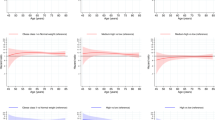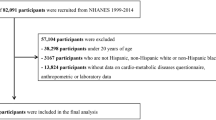Abstract
Background:
Inadequate control for potential methodological biases has been suggested as an explanation for the conflicting findings concerning the relationship between body mass index (BMI) and mortality.
Methods:
Using data from the Shanghai Women's Health Study, a prospective cohort study conducted in a relatively lean population, we examined the associations of BMI at various ages and average adult BMI with mortality and evaluated the impact of potential biases related to preexisting illness and cigarette smoking on the associations. Included in the analysis were 74 896 women aged 40–70 years with anthropometrics taken by trained interviewers at baseline (1996–2000). Recalled body sizes at ages 20 and 50 years were also obtained for older women. Participants were followed through April 2007 by biennial home visits and linkage with the vital statistics registry.
Results:
During a mean follow-up of 7.4 years, 2389 deaths occurred. In initial analyses, both low and high levels of baseline BMI were associated with an increase in mortality, whereas mortality increased monotonically with increasing levels of average adult BMI, BMI at the age of 50 years and, to a lesser extent, BMI at the age of 20 years. A direct monotonic relationship between baseline BMI and mortality emerged after accounting for potential biases. Controlling for potential biases also strengthened the positive associations of average adult BMI and BMI at ages 20 and 50 years with mortality, with a hazard ratio comparing the highest vs the lowest quartiles of average adult BMI reaching 2.19 (95% CI, 1.67–2.88).
Conclusion:
High BMI during adulthood consistently predicts mortality risk after accounting for potential biases.
This is a preview of subscription content, access via your institution
Access options
Subscribe to this journal
Receive 12 print issues and online access
$259.00 per year
only $21.58 per issue
Buy this article
- Purchase on Springer Link
- Instant access to full article PDF
Prices may be subject to local taxes which are calculated during checkout


Similar content being viewed by others
References
Manson JE, Bassuk SS, Hu FB, Stampfer MJ, Colditz GA, Willett WC . Estimating the number of deaths due to obesity: can the divergent findings be reconciled? J Womens Health (Larchmt) 2007; 16: 168–176.
Willett WC, Hu FB, Colditz GA, Manson JE . Underweight, overweight, obesity, and excess deaths. JAMA 2005; 294: 551.
Willett WC, Dietz WH, Colditz GA . Guidelines for healthy weight. N Engl J Med 1999; 341: 427–434.
Stampfer M . Weight loss and mortality: what does the evidence show? PLoS Med 2005; 2: e181.
Adams KF, Schatzkin A, Harris TB, Kipnis V, Mouw T, Ballard-Barbash R et al. Overweight, obesity, and mortality in a large prospective cohort of persons 50–71 years old. N Engl J Med 2006; 355: 763–778.
Greenberg JA . Correcting biases in estimates of mortality attributable to obesity. Obesity (Silver Spring) 2006; 14: 2071–2079.
Zheng W, Chow WH, Yang G, Jin F, Rothman N, Blair A et al. The Shanghai Women's Health Study: rationale, study design, and baseline characteristics. Am J Epidemiol 2005; 162: 1123–1131.
Shu XO, Yang G, Jin F, Liu D, Kushi L, Wen W et al. Validity and reproducibility of the food frequency questionnaire used in the Shanghai Women's Health Study. Eur J Clin Nutr 2004; 58: 17–23.
Matthews CE, Shu XO, Yang G, Jin F, Ainsworth BE, Liu D et al. Reproducibility and validity of the Shanghai Women's Health Study physical activity questionnaire. Am J Epidemiol 2003; 158: 1114–1122.
Korn EL, Graubard BI, Midthune D . Time-to-event analysis of longitudinal follow-up of a survey: choice of the time-scale. Am J Epidemiol 1997; 145: 72–80.
Harrell Jr FJ . Regression Modeling Strategies: with Applications to Linear Models, Logistic Regression, and Survival Analysis. Springer Series in Statistics. Springer-Verlag: New York, 2001.
Manson JE, Willett WC, Stampfer MJ, Colditz GA, Hunter DJ, Hankinson SE et al. Body weight and mortality among women. N Engl J Med 1995; 333: 677–685.
Calle EE, Thun MJ, Petrelli JM, Rodriguez C, Heath Jr CW . Body-mass index and mortality in a prospective cohort of US adults. N Engl J Med 1999; 341: 1097–1105.
Gelber RP, Kurth T, Manson JE, Buring JE, Gaziano JM . Body mass index and mortality in men: evaluating the shape of the association. Int J Obes (Lond) 2007; 31: 1240–1247.
Baik I, Ascherio A, Rimm EB, Giovannucci E, Spiegelman D, Stampfer MJ et al. Adiposity and mortality in men. Am J Epidemiol 2000; 152: 264–271.
Lawlor DA, Hart CL, Hole DJ, Davey Smith G . Reverse causality and confounding and the associations of overweight and obesity with mortality. Obesity (Silver Spring) 2006; 14: 2294–2304.
Losonczy KG, Harris TB, Cornoni-Huntley J, Simonsick EM, Wallace RB, Cook NR et al. Does weight loss from middle age to old age explain the inverse weight mortality relation in old age? Am J Epidemiol 1995; 141: 312–321.
Flegal KM, Graubard BI, Williamson DF, Gail MH . Excess deaths associated with underweight, overweight, and obesity. JAMA 2005; 293: 1861–1867.
Gu D, He J, Duan X, Reynolds K, Wu X, Chen J et al. Body weight and mortality among men and women in China. JAMA 2006; 295: 776–783.
Hu FB . Obesity and mortality: watch your waist, not just your weight. Arch Intern Med 2007; 167: 875–876.
Zhang X, Shu XO, Yang G, Li H, Cai H, Gao YT et al. Abdominal adiposity and mortality in Chinese women. Arch Intern Med 2007; 167: 886–892.
Hu FB, Willett WC, Li T, Stampfer MJ, Colditz GA, Manson JE . Adiposity as compared with physical activity in predicting mortality among women. N Engl J Med 2004; 351: 2694–2703.
Folsom AR, Kushi LH, Anderson KE, Mink PJ, Olson JE, Hong CP et al. Associations of general and abdominal obesity with multiple health outcomes in older women: the Iowa Women's Health Study. Arch Intern Med 2000; 160: 2117–2128.
Kopelman PG . Obesity as a medical problem. Nature 2000; 404: 635–643.
Van Gaal LF, Mertens IL, De Block CE . Mechanisms linking obesity with cardiovascular disease. Nature 2006; 444: 875–880.
Calle EE, Kaaks R . Overweight, obesity and cancer: epidemiological evidence and proposed mechanisms. Nat Rev Cancer 2004; 4: 579–591.
Casey VA, Dwyer JT, Berkey CS, Coleman KA, Gardner J, Valadian I . Long-term memory of body weight and past weight satisfaction: a longitudinal follow-up study. Am J Clin Nutr 1991; 53: 1493–1498.
Tamakoshi K, Yatsuya H, Kondo T, Hirano T, Hori Y, Yoshida T et al. The accuracy of long-term recall of past body weight in Japanese adult men. Int J Obes Relat Metab Disord 2003; 27: 247–252.
Rao C, Yang G, Hu J, Ma J, Xia W, Lopez AD . Validation of cause-of-death statistics in urban China. Int J Epidemiol 2007; 36: 642–651.
Acknowledgements
This study was supported by research Grants R01CA70867 and R01HL079123 from the National Institutes of Health. Dr Zhang was supported by an NIH-sponsored Building Interdisciplinary Research Careers in Women's Health (BIRCWH) Program at Vanderbilt University (2K12HD043483-06).
Author information
Authors and Affiliations
Corresponding author
Additional information
Conflicts of interest
None.
Supplementary Information accompanies the paper on International Journal of Obesity website (http://www.nature.com/ijo)
Supplementary information
Rights and permissions
About this article
Cite this article
Zhang, X., Shu, XO., Chow, WH. et al. Body mass index at various ages and mortality in Chinese women: impact of potential methodological biases. Int J Obes 32, 1130–1136 (2008). https://doi.org/10.1038/ijo.2008.63
Received:
Revised:
Accepted:
Published:
Issue Date:
DOI: https://doi.org/10.1038/ijo.2008.63



